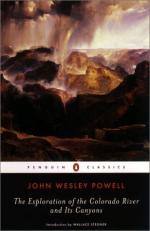|
This section contains 192 words (approx. 1 page at 400 words per page) |

|
Chapter XV, The Grand Canyon Summary and Analysis
The length of the Grand Canyon is two hundred seventeen miles. The bottom by the river is composed of black gneiss, slates and schists and is about eight hundred feet thick. This is called the black gneiss layer. The next is also eight hundred feet thick and is called the variegated quartzite layer. Next is five hundred feet of sandstone called cliff sandstone and then seven hundred feet of bedded sandstone and limestone. This layer is called alcove sandstone. The next layer, called red wall limestone, consists of sixteen hundred feet of limestone. Then comes the banded sandstone layer, which is eight hundred feet of gray and red sandstone. There is then one thousand feet of Aubrey limestone called tower limestone. This is the composition of the walls of the canyon and gives...
(read more from the Chapter XV, The Grand Canyon Summary)
|
This section contains 192 words (approx. 1 page at 400 words per page) |

|




